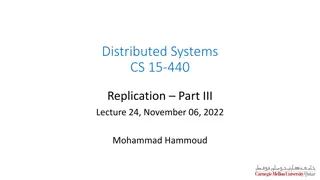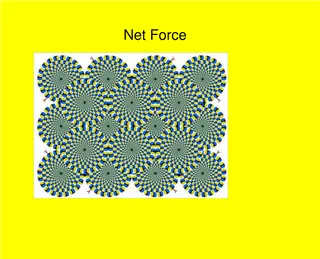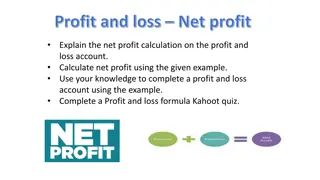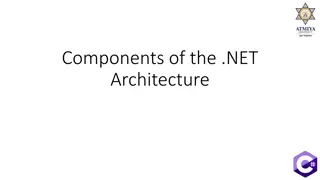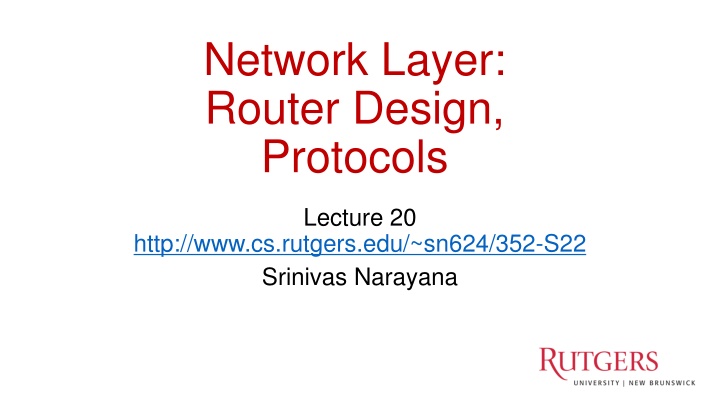
Router Design and Protocols in the Network Layer
Dive into the intricacies of router design and protocols in the network layer, covering concepts such as route processor, high-speed switching fabric, input/output ports, and more. Explore the goal of switching fabrics, nonblocking fabrics, and the role of the control processor in managing data flow efficiently.
Download Presentation

Please find below an Image/Link to download the presentation.
The content on the website is provided AS IS for your information and personal use only. It may not be sold, licensed, or shared on other websites without obtaining consent from the author. If you encounter any issues during the download, it is possible that the publisher has removed the file from their server.
You are allowed to download the files provided on this website for personal or commercial use, subject to the condition that they are used lawfully. All files are the property of their respective owners.
The content on the website is provided AS IS for your information and personal use only. It may not be sold, licensed, or shared on other websites without obtaining consent from the author.
E N D
Presentation Transcript
Network Layer: Router Design, Protocols Lecture 20 http://www.cs.rutgers.edu/~sn624/352-S22 Srinivas Narayana 1
Quick recap of concepts route processor high-speed switching fabric router input ports router output ports Forwarding Table Dst-network Port host part network part 65.0.0.0/8 128.9.0.0/16 3 1 The Internet uses destination IP based forwarding. 11001000 00010111 00010000 00000000 200.23.16.0/23 149.12.0.0/19 7
Input port Output port Review: Fabrics Switching fabric Input port Output port Fabric goal: Ferry as many packets as possible from input to output ports as quickly as possible. Input port Output port
Input port Output port Nonblocking fabrics Switching fabric Input port Output port Input port Output port High-speed switching fabrics designed to be nonblocking: If an output port is available , an input port can always transmit to it without being blocked by the switching fabric itself Crossbars are nonblocking by design Shared memory can be designed to be nonblocking if memory is optimized to be fast enough
Input port Output port Nonblocking fabrics Switching fabric Input port Output port Input port Output port With a nonblocking fabric, queues aren t formed due to the switching fabric. With a nonblocking fabric, there are no queues due to inefficiencies at the input port or the switching fabric Queues only form due to contention for the output port Fundamental, unavoidable, given the route
Input port Output port Nonblocking fabrics Switching fabric Input port Output port Input port Output port With a nonblocking fabric, queues aren t formed due to the switching fabric. With a nonblocking fabric, there are no queues due to inefficiencies at the input port or the switching fabric Queues only form due to contention for the output port Fundamental, unavoidable, given the route Typically, these queues form on the output side But can also backpressure to the input side if there is high contention for the output port i.e.: can t move pkts to output Qs since buffers full, so buffer @ input
Control (plane) processor A general-purpose processor that programs the data plane: Forwarding table Scheduling and buffer management policy Implements the routing algorithm by processing routing protocol messages Mechanism by which routers collectively solve the Internet routing problem More on this soon. Control Processor Input port Output port Switching fabric Input port Output port Input port Output port
Router design: the bigger picture Control plane Traditional distributed routing: per route- change processing (~ a few tens of seconds) Routing Algorithm control plane data plane Data plane per-packet processing (~ tens of nanoseconds) 0111 1 2 3 values in arriving packet header, i.e, destination IP address
Review: Route lookup Table lookup matches a packet against an IP prefix Ex: 65.12.45.2 matches 65.0.0.0/8 Extract destination IP address Transport Parse Network Link layer Prefixes are allocated to organizations by Internet registries Route Lookup Data Structure Outgoing Port Forwarding Table Dst-network Port But organizations can reallocate a subset of their IP address allocation to other orgs 65.0.0.0/8 128.9.0.0/16 3 1 149.12.0.0/19 7
Example of IP block reallocation Dst IP Prefix Output port Suppose ISP A reallocates a part of its IP block to orgs 1 8 65.0.0.0/8 128.9.0.0/16 200.23.16.0/20 3 1 7 (towards A) ISP A owns the IP block 200.23.16.0/20. Organization 1 200.23.16.0/23 200.23.18.0/23 Organization 2 ... ISP A 200.23.20.0/23 Organization 3 ... Internet Organization 8 200.23.30.0/23 There is an announcement mechanism (BGP) by which ISP A can inform the rest of the Internet about the prefixes it owns. It is enough to announce a coarse-grained prefix 200.23.16.0/20 rather than 8 separate sub-prefixes. Route Aggregation Save forwarding table memory Fewer routing protocol msgs
Example of IP block reallocation Dst IP Prefix Output port Suppose ISP A reallocates a part of its IP block to orgs 1 8 65.0.0.0/8 128.9.0.0/16 200.23.16.0/20 3 1 7 (towards A) ISP A owns the IP block 200.23.16.0/20. Organization 1 200.23.16.0/23 200.23.18.0/23 Organization 2 ... ISP A 200.23.20.0/23 Organization 3 ... Internet Organization 8 200.23.30.0/23 Now suppose one of these organizations adds another ISP for its Internet service and prefers using the new ISP. Note: it s possible for the organization to retain its assigned IP block.
Example of IP block reallocation Dst IP Prefix Output port Suppose ISP A reallocates a part of its IP block to orgs 1 8 65.0.0.0/8 128.9.0.0/16 200.23.16.0/20 3 1 7 (towards A) ISP A owns the IP block 200.23.16.0/20. Organization 1 200.23.16.0/23 200.23.18.0/23 Organization 2 ... ISP A 200.23.20.0/23 Organization 3 ... Internet Organization 8 200.23.30.0/23 ISP B Organization 2 200.23.18.0/23
Example of IP block reallocation Dst IP Prefix Output port Suppose ISP A reallocates a part of its IP block to orgs 1 8 65.0.0.0/8 128.9.0.0/16 200.23.18.0/23 200.23.16.0/20 3 1 4 (towards B) 7 (towards A) ISP A owns the IP block 200.23.16.0/20. Organization 1 200.23.16.0/23 200.23.18.0/23 Organization 2 ... ISP A 200.23.20.0/23 Organization 3 ... Internet Organization 8 200.23.30.0/23 ISP B Organization 2 200.23.18.0/23
A closer look at the forwarding table Dst IP Prefix Output port 200.23.18.0/23 is inside 200.23.16.0/20 65.0.0.0/8 128.9.0.0/16 200.23.18.0/23 200.23.16.0/20 3 1 4 (towards B) 7 (towards A) A packet with destination IP address 200.23.18.xx is in both prefixes i.e., both entries match Q: How should the router choose to forward the packet? The org prefers B, so should choose B 200.23.16.0/20
Longest Prefix Matching (LPM) Dst IP Prefix Output port Use the longest matching prefix, i.e., the most specific route, among all prefixes that match the packet. 65.0.0.0/8 128.9.0.0/16 200.23.18.0/23 200.23.16.0/20 3 1 4 (towards B) 7 (towards A) Policy borne out of the Internet s IP allocation model: prefixes and sub-prefixes are handed out Internet routers use longest prefix matching. Very interesting algorithmic problems Challenges in designing efficient software and hardware data structures 200.23.16.0/20
Internet routers perform longest- prefix matching on destination IP addresses of packets.
Verizon Rutgers Why is LPM prevalent? AT&T An ISP (e.g., Verizon) has allocated a sub-prefix (or subnet ) of a larger prefix that the ISP owns to an organization (e.g., Rutgers) Further, the ISP announces the aggregated prefix to the Internet to save on number of forwarding table memory and number of announcements The organization (e.g., Rutgers) is reachable over multiple paths (e.g., through another ISP like AT&T) The organization has a preference to use one path over another, and expresses this by announcing the longer (more specific) prefix Internet routers forward based on the longer prefix
Transport Network Link layer total datagram length (bytes) IP protocol version 32 bits number header length (bytes) type of service hdr len ver length fragment offset Bits for for fragmentation/ reassembly traffic differentiation e.g., audio, web, bulk (more on this later) flags 16-bit identifier time to live max number remaining hops (decremented at each router) upper protocol header checksum 32-bit source IP address 32-bit destination IP address upper layer protocol to deliver payload to, e.g., TCP, UDP E.g. timestamp, record the route taken, specify list of routers to visit ( source routing ) Options (if any) How much header overhead? Suppose 20 bytes of TCP 20 bytes of IP = 40 bytes data (variable length, typically a TCP or UDP segment) 20
The rest of this lecture and the next We ll talk about some support protocols and mechanisms for the network layer Protocols: DHCP, ICMP, ARP Mechanisms: NAT We ll also talk about IP version 6 (IPv6) Some of these protocols use an IP header underneath their own header (ICMP) or replace the IP header with their own (ARP) But these shouldn t be construed as transport/network protocols They are fundamental to supporting IP/network layer functionality More appropriately discussed as support protocols for the network layer
The network layer is all about reachability. Every protocol we ll see solves a sub-problem. How does an endpoint talk to another outside its network? Routing protocols OSPF, RIP, BGP How does an endpoint get an address? DHCP Debugging? ICMP How does an endpoint talk to another within the same network? ARP Gateways NAT & IPv6
Dynamic Host Configuration Protocol (DHCP)
How does an endpoint get its IP addr? One possibility: hard-code the IP address on the endpoint e.g., a system admin writing addresses in a file Linux: /etc/network/interfaces Mac OS X (10.14.6): system preferences > Network > name of interface > advanced > TCP/IP > Manually Another possibility: dynamically receive an address from the network DHCP: Dynamic Host Configuration Protocol Provide plug-and-play functionality for endpoints (e.g., phones, laptops)
Many similar bootstrapping problems How does a host get its IP address? How does a host know its local DNS server? How does a host know its netmask? i.e., so that it can know which other hosts are in the same network Note: the details how A and B talk to each other changes significantly when A and B are in the same network vs. different network How does a host know how to reach other networks? i.e., which router is at the border of the current network? This router is also called the gateway router: crucial for an endpoint to communicate with another endpoint external to the network
How DHCP works An endpoint that just joined a network knows nothing about it Endpoint doesn t even have an IP address for its point of attachment We solved a similar bootstrapping problem before: Domain Name Service (DNS) to retrieve addresses Often, it makes little sense to have the endpoint contact a known server to receive an IP address E.g., connecting to a brand-new network you ve never been in The only idea that really works is to ask everyone Broadcast a query
How DHCP works DHCP server 223.1.1.0/24 DHCP allows a host to dynamically obtain its IP address from a server on a network when it joins the network DHCP can allow a host to be mobile across different networks, obtaining IP addresses as needed DHCP uses leases on addresses Host must renew lease periodically Allows network to reuse an IP with an expired lease, reclaiming addresses from inactive hosts 223.1.2.1 223.1.1.1 223.1.1.2 223.1.1.4 223.1.2.9 223.1.2.2 223.1.3.27 223.1.1.3 223.1.2.0/24 DHCP Client program on the endpoint broadcasts message requesting an IP address. 223.1.3.2 223.1.3.1 223.1.3.0/24
DHCP client-server scenario DHCP discover 223.1.2.4 src : 0.0.0.0, 68 dest.: 255.255.255.255,67 yiaddr: 0.0.0.0 transaction ID: 654 Broadcast: is there a DHCP server out there? Arriving client DHCP server: 223.1.2.5 DHCP offer DHCP runs on UDP ports 67 (server) and 68 (client) Client s initial IP address is set to 0.0.0.0 Yiaddr stands for your IP address an address value the server sends to the client for consideration Note that the IP allocation has an associated lifetime (lease period) src: 223.1.2.5, 67 dest: 255.255.255.255, 68 yiaddrr: 223.1.2.4 transaction ID: 654 lifetime: 3600 secs Broadcast: I m a DHCP server! Here s an IP address you can use DHCP request src: 0.0.0.0, 68 dest:: 255.255.255.255, 67 yiaddrr: 223.1.2.4 transaction ID: 655 lifetime: 3600 secs Broadcast: OK. I ll take that IP address! DHCP ACK src: 223.1.2.5, 67 dest: 255.255.255.255, 68 yiaddrr: 223.1.2.4 transaction ID: 655 lifetime: 3600 secs Broadcast: OK. You ve got that IP address!
Multiple DHCP servers can coexist Server 1 Client Server 2 Collects replies Selects server 2
DHCP returns more than an IP address Name and IP address of the local DNS server Netmask of the IP network the host is on Useful to know whether another endpoint is inside or outside the current IP network Address of the gateway router to enable the endpoint to reach other IP networks
Your home router runs DHCP Likely, your home devices (laptops, tablets, phones) are all using DHCP-assigned IP addresses The DHCP server is running on the control processor of your home s access router (e.g., WiFi router) You can access the DHCP client program on Linux using the command dhclient and on Linux using sudo ipconfig <interface> DHCP
Summary of DHCP Want endpoints to have plug and play functionality Avoid tedious manual configuration of IP addresses and other information DHCP: a general bootstrapping mechanism for critical information required for network layer functionality Hosts can be simple: receive information from DHCP servers by broadcasting over the network







